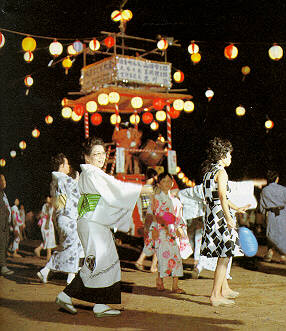
Japan in August
August 2-7: Nebuta Matsuri Festival
This takes place in the city of Aomori which is on the main tip of Honshu. It features a parade of huge lanterns in the shape of samurai warriors. The warriors shown are usually famous generals or characters from well-known kabuki plays.
The sizes of the lanterns vary, small ones for the children and ones as high as 26 feet and as long as 49 feet for the adults. The bigger ones are put on floats which are pulled by up to 50 people. Hundreds of male and female dancers perform around the floats.
Since the term nebuta means drowsiness it is thought that the festival is a way to wake up sleepy souls since the fall harvest season is coming up.
August 12-15: Aqa Odori
This festival takes place around Tokushima City on the island of Shikoku. Awa used to be the name for the Tokushima Prefecture.
Dancing is featured with people coming from all over Japan to participate or just watch. Dancers are grouped into teams called rens, made up of several dozen dancers. The term "dance", though, is being somewhat loosely applied here as the dance basically just consists of a person moving their arms and legs with as much vigor as possible.
There is also one rule: you must keep your hands and arms above your shoulders while dancing.
The dance itself goes back to 1585. The building of a new castle was completed and the people celebrated by getting drunk and started to dance, moving their arms and legs wildly.
It's also a very large event with at times over 200 teams participating and over a million people dance and/or just watch.
August 13-15: Bon holidays

The festival is also referred to as the O-Bon festival. Putting an "o" in front of something is a way to mark the great importance of that term, a way of honoring it.
This is the time of year when souls of the deceased are said to return to this plane of existence. Many people return to their home towns to the graves of their ancestors to clean up the grave site, burn incense and pray.
A Bon dance is held during the festival and is a community-wide activity.
In homes people will set up a "spirit altar" in front of their family Buddhist altar in order to welcome the souls of their ancestors. A welcoming fire for them is built on the 13th and a send-off fire is built on the 16th. The house is also given a thorough cleaning and dusting during this time with fruits and vegetables being offered at the family altar.
The end of the Bon festival is marked by taking small paper lanterns containing lit candles and floating them on rivers to light the way for the spirits of the ancestors as they depart. A message might be written on the outside of the paper lantern.
Daimon Temple Fire Festival (Daimon Ji Yaki Matsuri)
This is held at Hakone which is a mountain resort southwest of Tokyo. It is held on the slopes of Mt. Myojo. Torchers are arranged in the outline of a large Chinese kanji character -dai which means great and are then set fire. The purpose is to light the way for the spirits of the dead to return to Buddhist paradise after visiting with their living relatives during bon.
August 23-25: Kiriko Matsuri
The entire Noto Peninsula has kiriko festivals held in different communities on different dates. A kiriko is a rectangular, vertical lantern that can be up to three stories tall and is carried on the shoulders o young men. These are carried in a procession that ends up with a huge torch being lit on the beach.
The festival symbolizes the union of the male god of the town with the female god from the sea.
Misc. activities
This is also the general time for a variety of other activities.
1. Fireworks displays are held in various parts of Japan and are much looked-forward to. There are some 4,000 to 5,000 displays around the country during the summer with 250 of these being large-scale events.
2. Family outings. Since summer vacation is the longest vacation for school children families will take trips together at this time. The trips can include ones simply to some nature spot, the ocean or even overseas. This is also a time for children to visit their grand parents and see other relatives.
|